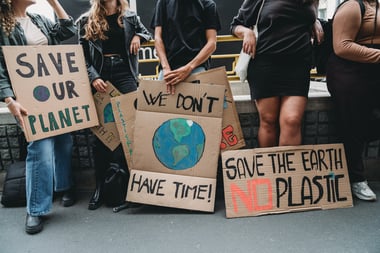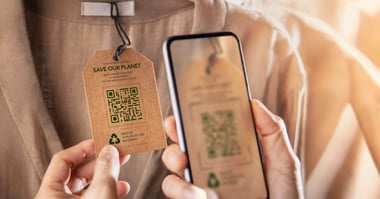
Tamara Davison
Tamara Davison is a journalist who specializes in sustainability and the environment. Reporting from around the world, she's seen firsthand the direct impact waste is having on coastal communities and our oceans. As a diver trained in ecological monitoring, the changes Tamara has seen in marine habitats inspired her to action. She's previously written for The Guardian, The Independent and the Evening Standard. She's also produced environmental documentaries for EuroNews.
Growing environmental awareness has prompted more conversations about plastic and carbon credits. Like many green initiatives, these are efforts to curb the negative impacts that businesses and consumers have on our world.
Ultimately, credit systems offer the opportunity for brands to share their profits with environmental services, to either help them grow or make them financially feasible in the first place.
For instance, plastic credits allow businesses to act on plastic pollution by investing in plastic collection initiatives. Carbon credits, on the other hand, concentrate on reducing carbon emissions that drive climate change.
On paper, both of these practices are inherently good — they address two pressing challenges facing our planet.
However, there’s also skepticism about how effective these credit systems actually are. That’s why we’re here to debunk, demystify, and answer all your burning questions about plastic credits and carbon credits.
What’s on this page?
01 | What's the difference between carbon credits and plastic credits?02 | Carbon credits vs plastic credits: environmental impact
03 | Carbon credits vs plastic credits: business impact
04 | Carbon credits vs plastic credits: economic impact
05 | Criticisms of carbon credits
06 | Criticisms of plastic credits
07 | How should we use carbon credits and plastic credits moving forward?
08 | FAQs
Carbon credits vs plastic credits: What’s the difference?
While both plastic and carbon credits aim to benefit the planet, the main difference is their outcomes. One is also more measurable than the other. Let’s take a closer look below.
Plastic credits
More than 2 billion people around the world don’t have access to proper waste management. Plastic credits address this by uniting businesses and coastal communities, in an effort to resolve this common problem.
Although each scheme differs slightly, businesses can use plastic credits to fund the removal of plastic and help prevent it from reaching the environment — with some brands even achieving plastic neutrality through this method.
Companies earn plastic credits by working with organizations committed to collecting a certain amount of plastic on their behalf. These environmental organizations usually partner with local communities, allowing businesses to help clean up plastic waste and support local environmental protection efforts.
Tracking and monitoring plastic recovery is usually much easier than tracking carbon emissions because plastic is a tangible object, meaning we can physically see results.
For example, CleanHub has helped collect over 8 million kg of waste worldwide, and businesses that fund this have access to a live dashboard and impact report to track and report every piece of plastic collected on their behalf.
This helps businesses remain accountable and ensure plastic collections align with credit purchases.
Why are plastic credits necessary — especially when it comes to non-recyclable materials?
Plastic credits add value to plastic, which is hugely beneficial considering the majority of collected plastic waste holds no monetary value (i.e it can’t be recycled, so it loses its ability to be used as a raw material).
To tackle this issue, we need to do three things: Switch to more sustainable materials, subsidize the collection of all plastic waste, and reduce the amount of plastic we consume globally.
But this all requires government intervention, innovation, and time.
A good first step to a circular economy is to build post-consumer waste collection systems around the world — and this is where plastic credits come in. This system can fund the optimization of plastic collection, while maintaining and growing collection recovery rates.
As long as the share of non-valuable waste outweighs the value in monetary terms, we'll need subsidies in the form of credits.
Carbon credits
Similar to plastic credits, carbon credits incentivize businesses to lower their impact on the planet — but this time it’s by reducing emissions.
Put simply, carbon credits are permits that allow businesses to emit a certain amount of carbon dioxide or other greenhouse gases — with one credit permitting the release of up to one ton of carbon dioxide equivalent (CO2e) emissions.
Credits are frequently issued under what’s known as a “cap-and-trade” program. In countries with a limit on greenhouse gas (GHG) emissions, companies that lower their emissions can sell their carbon credits to other businesses that aren’t compliant with existing emissions caps, meaning both parties benefit from the system.
Over time, the government reduces the amount of credits available in the market, meaning businesses will have no option but to reduce emissions. The idea is that by incentivizing businesses to transition to greener operations, others can continue releasing emissions in a regulated way.
People often confuse the term ‘carbon credits’ with ‘carbon offsets’. There is, however, a key difference between the two.
Carbon credits vs. carbon offsets
Despite sharing the same goal of reducing emissions, carbon credit systems and carbon offsetting schemes operate in slightly different ways.
To make things confusing the two terms are frequently used interchangeably — but here’s how they differ:
- Carbon credits — Carbon credits act as a permission slip for businesses to produce a certain amount of emissions. When a company buys a carbon credit, it gains permission to generate one ton of CO2 emissions — and if it reduces emissions, it can sell this carbon credit to other companies
- Carbon offsetting schemes — Some businesses reduce their carbon footprint by investing in climate action projects to balance out their emissions. This is commonly known as carbon offsetting. The idea is that by doing this, the business’s emissions and the climate projects counteract each other, achieving climate neutrality. Popular initiatives include renewable energy projects, improving energy efficiency, carbon and methane capture and sequestration, and reforestation projects.
It’s important to note that there has been a lot of criticism of carbon offsetting projects in recent years, with climate experts finding many don’t work. As a result, the carbon offset market shrank for the first time in 2023, as businesses look for more impactful solutions — but more on that later.
Carbon credits vs plastic credits: environmental impact
The primary goal of carbon and plastic credits is to support the environment. However, these initiatives yield different results.
Plastic credits
Experts believe around 5.25 trillion pieces of plastic debris float in our oceans. While plastic recycling initiatives help reduce growing waste, the amount of plastic polluting our environment already requires a mammoth cleanup task. This is where plastic credits come in.
Given that just 9% of plastic is recycled, and a vast amount of plastic waste is mismanaged, plastic collection programs funded through credit systems help clean up the environment. The organizations behind plastic credit initiatives structure clean-up and collection efforts by working with grassroots organizations, ensuring safe and efficient collection facilities and recycling collected waste.
This means businesses working with plastic credit projects can support the development of more sustainable waste practices and help local communities.
Some industries will also struggle to find sustainable solutions to plastic packaging straight away — but plastic credits offer a solution that’s immediately available for brands that don’t have any better packaging alternatives available right now.
Carbon credits
Mainly facilitated by burning fossil fuels, carbon emissions release carbon dioxide into the atmosphere, contributing to atmospheric warming and climate change. Emissions have risen by 90% in the last 50 years, and experts predict they’ll continue to grow.
Carbon credit systems can benefit the environment, as businesses work toward reducing their carbon emissions — and in some cases, it works. One study found that 34 companies used carbon credits to reduce an impressive 38 million tonnes of carbon dioxide between 2020 and 2022.
McKinsey also forecasts that by 2030, the demand for carbon credits could equal 8–12 gigatonnes (a billion metric tons) of CO2, suggesting more companies are coming around to take accountability for their emissions.
However, other studies have raised questions about the effectiveness of carbon credits. This year, global emissions reached an all-time high, suggesting that existing carbon credit programs have done little to curb soaring levels.

Carbon credits vs plastic credits: business impact
As well as benefiting the environment, plastic and carbon credit initiatives are also designed to help the businesses themselves.
Plastic credits
Investments in plastic recycling initiatives are growing, suggesting there’s a financial incentive for businesses committing to plastic credit projects. A strong environmental commitment is something that both consumers and investors are increasingly looking to support.
Regarding compliance and regulation, plastic credits can also help businesses meet requirements set by governing bodies. For example, some countries have integrated plastic credits into their Extended Producer Responsibility (EPR) programs, meaning businesses operating there are responsible for managing their waste.
Companies can partner with plastic credit organizations to comply with EPR and meet plastic collection requirements. Modern technology also makes this partnership transparent, which benefits everyone involved.
For example, at CleanHub, our transparent tracking technology helps business reach their EPR goals, allowing them to report the results with confidence, and making it easier to demonstrate sustainable goals to wider governing bodies.
As a result, companies can prove their impact to customers and the authorities while avoiding the risks of greenwashing.
Carbon credits
One study found that companies involved in carbon credit initiatives decarbonized twice as fast as those not involved. The argument is that companies engaged with carbon initiatives can set internal prices, incentivizing further decarbonization.
Using carbon credits may encourage companies to think long-term about their environmental impact and efficiency. The monetary outcome of selling carbon credits can be re-invested into other parts of the business.
Being carbon neutral can also drive further consumer support. Around 81% of consumers want to support sustainable businesses, and this is a great way to prove to shoppers that you’re taking that commitment seriously.
Of course, companies must also be mindful of being held to account. Some businesses have gotten into trouble with their carbon credit system by making misleading claims, so transparency and long-term sustainable goals are critical.
Carbon credits vs plastic credits: economic impact
When used correctly, carbon and plastic credits can be considered long-term investments and part of a broader plan to embrace sustainability.
Plastic credits
If municipal governments were responsible for waste management alone, there would be a $40 billion funding deficit for plastic removal and waste management by 2040. Plastic credit initiatives are therefore vital, as they help spread the cost and boost collective waste recovery efforts.
On top of that, plastic credits help provide additional income to coastal communities and validate the work of informal waste pickers. It means they can afford to support their families with the extra money they earn.
Plastic credits also feed into a circular economy model — the idea that we can extend the life of items through recycling and reusing, to prevent them from going to waste. If anything, plastic credit systems prove that a circular economy model works and makes a real difference to the planet.
Carbon credits
In 2022, the carbon credit market was valued at $87 billion, with some predictions expecting this to grow by 14.2% by 2032. As more governments incentivize carbon emissions, there may be more economic growth in this sector.
The result could be that it stimulates more jobs and further innovation. As companies explore emission reduction efforts, it could lead to more research and development into sustainable technologies and business initiatives.
At COP28, world leaders discussed the possibility of integrating a global carbon credits model in the near future, but plans were scuppered as some nations urged there needs to be more transparency and accountability.
Criticisms of carbon credits
There have been rising concerns with both carbon credits and carbon offsetting schemes over the past few years — mainly due to their lack of transparency.
In 2023, a researcher from the University of Berkley reported that ‘bogus carbon credits were a pervasive problem,’ citing a lack of regulation as a significant issue.
The Guardian similarly revealed that 90% of carbon offsets produced by the world’s most prominent organization were worthless and didn’t contribute to meaningful action.
On top of this, there have been reports of so-called “carbon cowboys”, who act as a middleman between businesses and providers and work in poorly governed carbon markets. These intermediaries pay offset projects in low-income nations less than what they deserve, and then sell the credits with a larger profit.
To make matters worse, a watchdog group reported that 90% of the intermediaries don’t reveal the exact fees or profits they earned from selling carbon credits.
Something needs to change — but this doesn't mean we should shun the idea of carbon credits entirely. We know these projects stimulate more awareness and internal business efforts to reduce emissions, but there needs to be much more transparency in the industry.
Criticisms of plastic credits
As more consumers brush up on their greenwashing knowledge, there has been a rise in plastic credit scrutiny — especially after the carbon credit scandals.
Transparency is the biggest challenge facing plastic credits. The United Nations Environment Program (UNEP) highlighted that there is currently no global standardization of plastic credits, meaning there are a lot of initiatives operating by themselves and lacking transparent communication about their success.
Another common criticism of the plastic credit system is that some businesses treat it as a silver bullet to the plastic pollution crisis, instead of integrating it into a broader plan to reduce plastic waste.
Plastic credits aren’t the only answer to the world’s waste challenge — we need to be utilizing them whilst also reducing single-use plastic waste at the source.
As a company operating in the plastic credit sector, we want to set the bar high when it comes to standards. We ensure accountability, collaboration, and transparency thanks to our trash tracking technology, which outlines a clear audit trail of the plastic we collect.
Find out more by visiting our technology page, where we also have a live dashboard of our collections.
We also offer brands a packaging assessment with our experts, so they can analyse which areas of their business could reduce its impact on the planet, and whether there are any alternative materials that could be utilized.
Want to learn more about how your business can approach plastic waste? Connect with us today for a packaging assessment and learn our experts' best strategies for overall plastic management.
How should we use carbon credits and plastic credits moving forward?
Credit systems fail when seen as the ‘be-all and end-all’ solution to our planet’s environmental problems.
Businesses cannot rely on these systems to eliminate their issues, nor are consumers buying that approach any longer. Credit systems must form part of a broader business initiative committed to improved sustainability.
Both carbon and plastic credit initiatives must be more transparent to build trust. A study by the European Commission found that 85% of offset projects had a “low likelihood of ensuring environmental integrity.” Failure to embrace accountability undermines trust and the overall effectiveness of such initiatives. This is where things need to change.
The bigger picture also involves considering how credit systems can serve as a tool for promoting a circular economy. Early circular economy initiatives have already generated more jobs and added value to the local economy. When used correctly, credit systems can benefit both businesses and the environment in this area.
Summary
We know there’s a lot to wrap your head around regarding carbon and plastic credit systems.
While the ultimate goal is to end plastic and carbon production, we’re realistic that this process won’t happen overnight. That’s why carbon and plastic credit systems, despite drawbacks, still have the potential to help.
The critical thing to remember is that while they are similar in practice, carbon and plastic credit programs are different. You can quantify the results of plastic credit initiatives much more efficiently, leading to more trustworthy results that consumers can get behind.
At CleanHub, we work with brands to reduce plastic pollution in vulnerable areas that lack proper waste management. What's in it for the brands? Find out everything you need to know in our guide on Turning Green to Gold.
FAQs
What are the disadvantages of carbon credits?
Some experts argue that carbon credits are disadvantageous because measuring the results is difficult. Scientists have found that some carbon offset programs don’t work, so the process is prone to greenwashing.
What are the basics of carbon credits?
The basics of carbon credits are that businesses are awarded credits based on their emissions. This forms part of a cap-and-trade program, allowing companies to profit by selling their credits if they can reduce emissions.
How much is 1 carbon credit worth?
One carbon credit is worth 1 ton of carbon emissions, equivalent to driving one gas-powered car for half a year. To capture a ton of carbon emissions, 50 trees must grow for a year.


.webp?width=380&name=Picking-up-plastic-waste%20(1).webp)


.webp?width=380&name=ESG-laptop%20(1).webp)

.webp?width=380&name=CleanHub-processing%20(1).webp)
.webp?width=380&name=Diversity-and-inclusion%20(1).webp)



